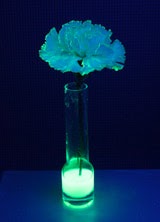Chemistry of everyday life
In this lens I'd like to talk you about the Chemistry of daily
life. Chemistry is an exciting experimental science which lets us to understand
our world and makes our life easier. As you will read in the following articles,
chemistry is in our everyday life: in our body, at home, in the nature... in
every second of our lives!
How soap cleans?
There are substances which can be dissolved in water (salt for
example), and others that can't (for example oil). Water and oil don't mix
together, so if we try to clean an oily stain from a cloth or from the skin,
water is not enough. We need soap.
Soap is formed by molecules with a "head" which likes water (hydrophilic) and a long chain which hates it (hydrophobic).
Because of this dualism, soap molecules act like a diplomat, improving the relationship between water and oil. How? When soap is added to the water, the hydrophilic heads of its molecules stay into the water (they like it!), while the long hydrophobic chains join the oil particles and remain inwards (escaping from the water). In that way, they form circular groups named miscelles, with the oily material absorbed inside and trapped.
An emulsion of oil in water is then formed, this means that the oil particles become suspended and dispersed into the water. Thus, those oil particles are liberated from the cloth or the skin, and the emulsion is taken away with the rinsing.
In summary, soap cleans by acting as an emulsifier. It allows oil and water to mix so that oily grime can be removed during rinsing. There are more things involved in this process, such as for instance changes in the superficial tension of water, but this is the general idea.
Soap is formed by molecules with a "head" which likes water (hydrophilic) and a long chain which hates it (hydrophobic).
Because of this dualism, soap molecules act like a diplomat, improving the relationship between water and oil. How? When soap is added to the water, the hydrophilic heads of its molecules stay into the water (they like it!), while the long hydrophobic chains join the oil particles and remain inwards (escaping from the water). In that way, they form circular groups named miscelles, with the oily material absorbed inside and trapped.
An emulsion of oil in water is then formed, this means that the oil particles become suspended and dispersed into the water. Thus, those oil particles are liberated from the cloth or the skin, and the emulsion is taken away with the rinsing.
In summary, soap cleans by acting as an emulsifier. It allows oil and water to mix so that oily grime can be removed during rinsing. There are more things involved in this process, such as for instance changes in the superficial tension of water, but this is the general idea.


Comments
Post a Comment